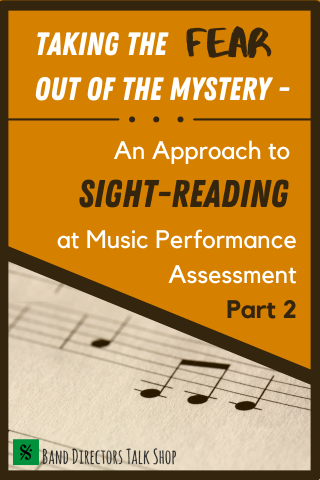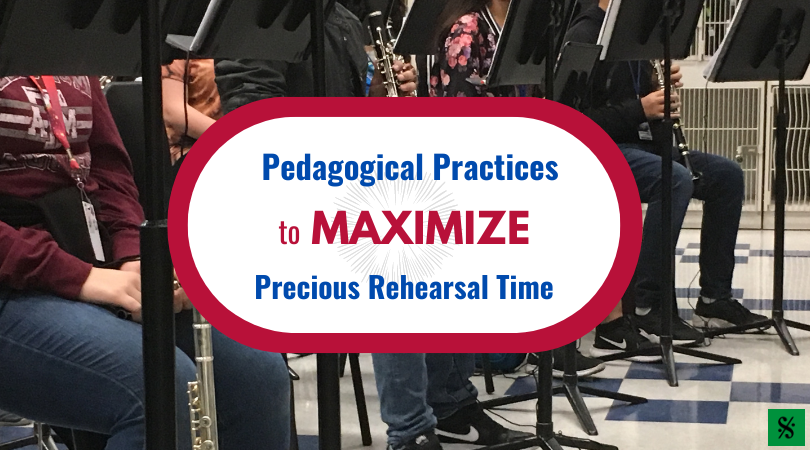In part 1 of this series, we discussed some of the most important aspects of sight-reading. Namely, quality of sound and playing with musical intent. We also covered how to prepare your band or orchestra during the 1st semester by focusing on rhythmic skill development using the “Rhythm, Keys, and Time” series. In Part 2, we will focus on how to continue preparing during the 2nd semester.

2nd Semester
Early in the year, begin building a library of sight-reading music. In Texas, the past year’s sight-reading pieces are available for purchase from the publisher, RBC Publications. We would keep a separate set of folders with only those sight-reading pieces included. We were fortunate enough to buy several examples of sight-reading music for each grade level to use as a classroom set. Beginning approximately 6-8 weeks from the assessment event, we would begin teaching the “process and procedure” we used in the sight-reading room. We would start with once or twice per week and then gradually increase this to three to four times per week as we got closer to the assessment. Like the rhythm exercises, we would start with the easier grade levels and then progress to a grade level more difficult than what they would be expected to play. By doing this, your students will have tremendous confidence when they first see the sight-reading music and realize they are more than prepared. This also allows you to focus more on the musical aspects of the music!
Setting Up
Make sure you have your parts assigned ahead of time as to who will play which part. In Texas, UIL has the instrumentation specified for each grade level of the sight-reading pieces on its website.
Percussion – make sure you have all the parts assigned to specific individuals and then rehearse several times before assessment. The students should play the same part every time! Since multiple percussion parts have to be covered, this will avoid last-minute confusion.
Winds – your sight-reading set need not be exactly as your on-stage set. Consider taking some of your more experienced players and interspersing, to the extent possible, with your younger players. Younger players learn more from the more experienced players sitting around them than they do from us! Consider taking one or two of your first clarinets, for example, and have them play a second or third part. The same could hold for any section with multiple sub-sections (trumpets, trombones, etc.). Have the more experienced student actually sit with the sub-section in which they are performing. Have them sit in the second chair on the row, not at the very end. That way, they will have younger players on either side of them. The older, more seasoned player then acts as an anchor for the younger players on either side of them. Make sure these older players are strong rhythmically. The younger players will not only gain confidence from having a stronger player sitting next to them, but they will also follow them musically.
Approach to Sight-Reading
The students will feed off of the type of energy and demeanor that you exude. If you are high-strung and anxious, there is a good chance your students will be as well. On the other hand, if you enter the sight-reading room with a relaxed, professional demeanor, then there is a good chance your students will emulate that as well. Your demeanor should be one of anticipation as you and your students excitedly discover a brand-new piece of music.
How the students enter the sight-reading room is very important, this is the first impression the judge will have of your students. Students should enter the room with a relaxed, professional demeanor. Understanding that the students come directly from the on-stage performance and are already mentally and emotionally spent. Gently remind them that they aren’t done just yet, and to remain focused on the task at hand.
Students must stay engaged 100% of the time, with relaxed professionalism but focused. I have discovered that this is the most critical and essential factor, next to being properly prepared ahead of time! While the judge is evaluating how well the director is teaching, they are also evaluating how well the students are learning. Students that are not focused, inattentive, distracted or talking, etc., have taken themselves “out of the game” and take the players on either side of them as well! Percussionists tend to be the most scrutinized as they are standing up and much more visible. Also, there may be more movement from the percussion section as they settle in and transition from the on-stage performance to the sight-reading room.
In part 3, we will cover the process, the study period, and how to be most efficient with your time.
Jon Bubbett is a retired band director from Alabama with over 40 years of teaching experience. He has presented at The Midwest Clinic and other states’ Music Education Associations. He has presented clinics throughout the southeast and has music published through Excelcia Music Publishing, Belwin Music, Eighth Note Publishing, RWS, and jonbubbettmusic.com.
Related Reading:
Teach Sight-Reading with TAKES (Quick Tip)
6 Benefits of Adding Rhythm Ear Training to Your Band Curriculum
How do You Teach Rhythmic Precision?
If you would like to receive our weekly newsletter, sign up here.
Don’t forget to like us on Facebook too!
Learn. Share. Inspire.
BandDirectorsTalkShop.com






Leave a Reply
You must be logged in to post a comment.